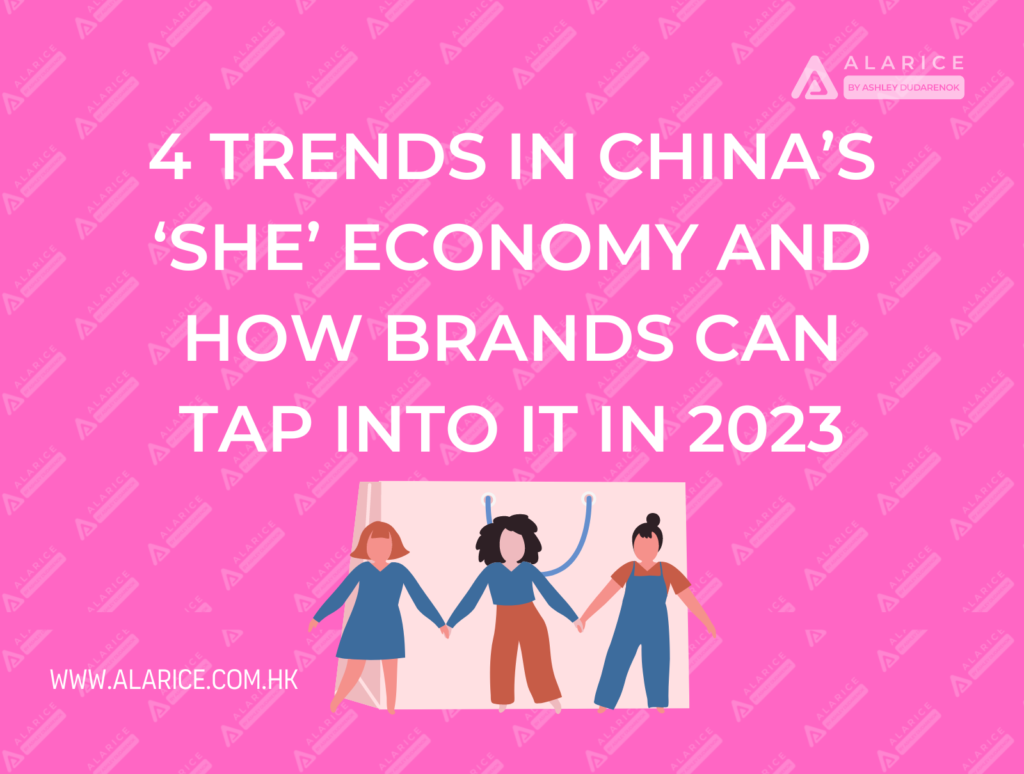The “she economy” in China is experiencing significant growth as more young, financially independent women are spending money on themselves. This trend is largely driven by female millennials and Gen Z members who seek happiness and self-fulfilment on their own terms, rather than through traditional roles and expectations.
According to a report by Alibaba, women in China are responsible for more than 70% of household purchases, including consumer goods, luxury products, and online shopping. This has led to the rise of female-oriented businesses, such as e-commerce platforms that cater to women’s preferences and needs.
As a result of this shift in attitudes, China now boasts the world’s third-largest consumer market for women, after the United States and Japan. In fact, the size of the Chinese women’s consumer market is equivalent to the combined retail markets of Germany, France, and the United Kingdom.
The growing economic power of women in China has significantly influenced the country’s economy, with businesses increasingly recognizing the importance of targeting female consumers and promoting gender diversity in their workforce. This has led to the rise of female-oriented businesses and products, such as e-commerce platforms that cater to women’s preferences and needs.
The Pandemic Impact
The COVID-19 pandemic has significantly impacted the she-economy in China, with both positive and negative effects. On the one hand, the pandemic has accelerated the shift towards e-commerce and digital platforms, benefiting female consumers who are more likely to shop online. Many companies have also increased their focus on female consumers, recognizing their growing economic power and the need to cater to their preferences and needs.
On the other hand, the pandemic has disproportionately affected women in the workforce, particularly those in the service sector, which has slowed the growth of the she economy. Many women have lost their jobs or experienced reduced working hours, which has impacted their financial independence and purchasing power.
With Chinese women becoming an increasingly powerful force in the consumer market, brands have a golden opportunity to tap into this burgeoning demographic. But with new trends and changes emerging all the time, it’s crucial for brands to stay ahead of the curve and understand what makes this market tick.
In 2023, the she economy is set to expand even further, offering brands the chance to make a big impact and establish themselves as leaders in this exciting space. In this article, we’ll explore the key trends and opportunities in the she economy in China and why it’s more important than ever for brands to get on board.
Whether you’re a seasoned player in the market or just starting out, there’s no better time to embrace the power of the she economy and unlock its full potential for your brand.
She-Economy Trends in China
Medical Beauty Proliferation
Source: MobTech, 2023 China Mega Report by ChoZan
There is a rising trend among younger Chinese to undergo cosmetic surgery to improve their self-esteem. In 2021, the medical aesthetics market in China was valued at 217.9 billion yuan, indicating a year-on-year growth rate of approximately 12%. This figure will exceed 400 billion yuan by 2025 according to current predictions. Not only is it widely accepted, but nearly 80% of Chinese Gen Z women are planning to undergo medical aesthetics, and at least 60% of those are willing to spend more than RMB 5000 on a procedure.
This significant growth in the medical aesthetics industry in China is largely attributed to the increasing demand for non-invasive and minimally invasive procedures, which are becoming more popular among younger generations. The availability of advanced technology and the growing acceptance of cosmetic surgery as a means of self-improvement are also factors contributing to the growth of this market. Some of the popular medical beauty trends in China include:
- Facial treatments: Non-invasive facial treatments such as Botox, fillers, and laser treatments are increasingly popular in China, as women seek to achieve a more youthful and radiant complexion.
- Body contouring: Women seek to achieve a more toned and streamlined figure with body sculpting treatments such as liposuction and CoolSculpting.
- Skin rejuvenation: Skin rejuvenation treatments such as chemical peels, microdermabrasion, and photofacials are popular in China. Women seek to reduce the appearance of fine lines, wrinkles, and hyperpigmentation.
- Hair restoration: Hair loss and thinning is a common concern for both men and women in China. Hair restoration treatments such as hair transplants and platelet-rich plasma therapy are becoming more popular.
- Traditional Chinese Medicine: Traditional Chinese Medicine (TCM) is also a growing trend in the medical beauty industry in China, with treatments such as acupuncture and cupping being used for facial rejuvenation and body contouring.
Premiumization on everything (贵替)
In China, there is an increasing trend toward premiumization. While in the past, the focus was on finding affordable alternatives, consumers are now more interested in premium options. This shift is reflected in the 20,000+ posts on RED related to “premiumization alternatives”. The demand for high-end skincare products is also growing among Chinese consumers, especially younger generations who prefer mid-to-high-end brands. As a result, premium brands are expected to continue outperforming mass-market brands in this industry.
The Food & Supplement Market
Source: LeadLeo, 2023 China Mega Report by ChoZan
Functional foods, which are designed to provide specific health benefits, are particularly popular in China’s women’s food and supplement market. These products (which can range from smoothie drinks to gummies) are often fortified with vitamins, minerals, and other nutrients that support women’s health needs, such as bone health, heart health, and hormonal balance. Additionally, there is a growing interest in beauty supplements, which are designed to improve skin health, hair health, and overall appearance. The compound annual growth rate for women’s health food is 10.4%, with an expected massive market development potential.
The increasing focus on traditional Chinese medicine and natural remedies also drives the food and supplement market for women in China. Many Chinese women prefer to use natural, plant-based supplements and remedies to support their health and well-being, rather than relying on synthetic products. In fact, 50% of Chinese Gen Z (and younger) women are using vitamins and supplements more often now than they did pre-pandemic.
China’s “Women’s Day”
International Women’s Day falls on March 8th and is an important marketing event for e-commerce platforms, coinciding with the launch of new spring products. This festival has replaced other previously celebrated events like Queen’s Day and Girls’ Day, with e-commerce platforms simplifying the celebration to the “3.8 Festival.” This simplification has helped normalise the festival’s promotion and clearly define the rhythm of the marketing activities. More and more Chinese women are finding happiness in self-fulfilment and have reshaped the Chinese economy by spending on their own terms.
The 3.8 Festival is an opportunity for e-commerce platforms to target the female demographic and offer special discounts and promotions on products that cater to women’s interests and needs. This event has become a significant business opportunity to boost sales and attract new customers.
As China’s e-commerce industry continues to grow and evolve, events like the 3.8 Festival are expected to become even more critical for businesses looking to attract and retain customers. The festival provides a valuable opportunity for businesses to showcase their products and services, and build brand awareness among their target audience. Catering to the female gaze is highly lucrative for the festival. In 2022, Li Jiaqi hit 2.83 billion RMB in Tmall sales which featured 279 products.
3 Ways to Attract Consumers for Women’s Day in 2023
As Women’s Day is fast approaching in 2023, businesses and marketers are gearing up to attract and engage with their female consumers. It allows businesses to show their appreciation for their female customers and attract new ones. In this context, businesses can use three key strategies to attract consumers for Women’s Day in 2023.
#1: Build strong emotional connections with the female consumer
Source: Proya’s Weibo official account @珀莱雅PROYA
To build an emotional connection with female consumers, businesses can tailor their marketing messages and product offerings to align with their values and interests. For example, a company that values sustainability can appeal to female consumers passionate about protecting the environment. LAN by Hangzhou Yige Cosmetics did this by incorporating a “clean beauty” product line into their ranks and livestreaming it to their followers on Tmall.
Creating a brand story that resonates with female consumers is also important. This involves creating a narrative around the brand that evokes emotion and inspires loyalty, such as a skincare company building a brand story around self-care and self-love. On March 8, 2022, PROYA introduced their new tagline “Gender is not the borderline, prejudice is” through outdoor advertisements that featured diverse images of women and men. The accompanying Weibo post generated significant engagement, receiving 136,000 likes, 51,000 shares, and over 5,000 comments. The post featured ad content that carried positive messaging on gender roles in China.
#2: Co-branding For Max Visibility
Source: CBNData
For Women’s Day, co-branding can be particularly effective as it allows brands to tap into the day’s emotional significance while increasing their visibility. For example, a fashion brand could collaborate with a beauty brand to offer a special Women’s Day gift set that includes a piece of clothing and a beauty product. This not only provides customers with a unique and thoughtful gift option but also allows both brands to leverage each other’s audience and increase their visibility.
In 2022, Libresse, an Essity brand specialising in period and intimate care products, teamed up with Yongpu, a coffee brand, for the 3.8 Festival celebration in China. Together, they launched the campaign “#Putting pads on the desk” and introduced a “Pad storage box”. The box was unique because it broke the stigma around menstrual products and was presented in a transparent box, showcasing the pads positively.
The goal of the collaboration was to promote the idea that women have the right to choose to put pads on their desks, just like they would put coffee or other daily necessities on their workspaces. By co-branding with a coffee company, Libresse expanded its reach to a wider audience and uniquely showcased its product. This collaboration not only provided convenience for women who needed to store their menstrual products, but it also helped to break down the social taboo around menstruation and promote gender equality.
#3: Attend 3.8 Festival Campaigns on Major E-commerce Platforms
Source: Xinhua News
Attending Women’s Day campaigns on major e-commerce platforms is another way businesses attract female consumers. During Women’s Day, major e-commerce platforms in China, such as Tmall and JD.com, often launch special promotions and sales events to attract shoppers. Businesses can increase their visibility and reach a wider audience by participating in these campaigns.
To make the most of these campaigns, businesses must develop effective marketing strategies that resonate with their target audience. This could include creating eye-catching advertising campaigns, offering exclusive discounts and promotions, and collaborating with influencers to promote their brand.
For example, in 2022, Taobao earned 70 million viewers on its Women’s Day campaign, featuring special promotions and activities focused on empowering women. The platform also recorded 2.8 billion RMB in sales during the first presale night. Brands that participated in the campaign had the opportunity to showcase their products and reach a wider audience of female shoppers.
Source: E-commerce News, 2023 China Mega Report by ChoZan
Douyin is a popular social media platform in China that offers various advertising formats, such as a brand takeover, in-feed video ads, hashtag challenges, and influencer collaborations. For Women’s Day campaigns, brands can leverage Douyin’s hashtag challenge feature to encourage user-generated content and build brand awareness. Florasis, a C-beauty brand, used Douyin’s livestreaming services to promote their new product, Florasis Balance Liquid Foundation. Douyin offers seamless integration with e-commerce platforms, allowing users to purchase products directly from the app.
By attending Women’s Day campaigns on major e-commerce platforms, businesses can attract new customers and build brand awareness and loyalty among existing customers.
What brands can do more for Women’s Day 2023:
To better target female consumers in 2023, brands should shift their focus from simply providing discounts and promotions during specific holidays to highlighting the power and achievements of women. By creating campaigns and topics that promote gender equality and women’s empowerment, brands can attract and engage female consumers who are passionate about these issues. This can include partnering with organisations that support women’s causes or creating content that celebrates the accomplishments of women in various fields.
Brands should also seek to create personalised and customised experiences for female consumers. This can include offering tailored product recommendations, personalised customer service, and exclusive access to events and promotions. By showing that they understand and value female consumers’ unique needs and preferences, brands can build a stronger emotional connection with this demographic, leading to increased loyalty and long-term customer relationships.
Conclusion
The easing of COVID-19 policies and the rebound in domestic demand are expected to drive solid growth prospects for China’s economy in 2023. “She-economy” will expand into more sectors in the post-pandemic era. In 2023, you can expect that there will be trends of “She Power,” “She Sharing,” and “She Consumption” so brands must watch out for this demographic.
With the increasing focus on fitness and healthy lifestyles, female consumers are becoming more empowered and active. They are also major users of social media platforms, where they share makeup and shopping tips, travel guides, and outfit ideas, providing valuable content for brand recommendations. Besides traditional “women’s” categories such as bags and skincare products, more women are expanding their consumption categories to include cars, wine, games, sports products, and more. With their high consumption power, Chinese women consumers will continue to provide new opportunities and growth for brands in the “she economy.”
Any brand looking to tap into this formidable market in China will need to understand and adjust as trends come and go in the Chinese “she economy”. Alarice can help you plan your marketing campaign and manage your content for a successful 2023 in China. We specialise in Chinese digital marketing, trend analysis, and market analytics at Alarice to ensure that your brand is in sync with Chinese customers. Contact us here.






